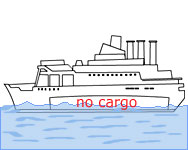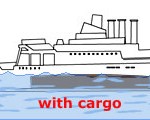For those of you that know me well, you know that I love to sail.
And so do my kids! So when my 9 year old son asked me the other day “Mom why does a boat float but a nail sink?" I was relieved that I could use science (yet again) to answer the question!! If you drop a nail into a cup of water it sinks, right?

Why do you think this is the case? Ok I’ll tell you!
The nail sinks because the density of the steel is greater than the density of the water. But ocean liners are made of steel so why do they float, and since they do float, why do they sometimes also sink? Everyone’s heard of gravity, that mysterious force that pulls everything downward, but did you know there is also an opposing force? Buoyancy is the push to gravity’s pull. Buoyancy is the force that floats your boat. To understand buoyant force, think about what happens when you put an ice cube into your glass of water.
 As the ice cube displaces, or pushes away, some of the water it causes the level in the glass to rise and your ice cube to float partially in and partially out of the water like a miniature iceberg. Like a game of tug-of-war; gravity is pulling the ice cube down and buoyant force is pushing it up. How far in or out of the water your ice cube rests depends on its density, or solidness, because that is what the pushing and pulling forces are working against. A Greek mathematician and inventor named Archimedes noticed that when he stepped into his bathtub the water level rose. He reasoned that the weight of the water he displaced was equal to the buoyant force in the water. This is called Archimedes Principle and it applies to all fluids.
As the ice cube displaces, or pushes away, some of the water it causes the level in the glass to rise and your ice cube to float partially in and partially out of the water like a miniature iceberg. Like a game of tug-of-war; gravity is pulling the ice cube down and buoyant force is pushing it up. How far in or out of the water your ice cube rests depends on its density, or solidness, because that is what the pushing and pulling forces are working against. A Greek mathematician and inventor named Archimedes noticed that when he stepped into his bathtub the water level rose. He reasoned that the weight of the water he displaced was equal to the buoyant force in the water. This is called Archimedes Principle and it applies to all fluids.
 Kids find it easy to remember Archimedes and his discovery when you ask them:
Kids find it easy to remember Archimedes and his discovery when you ask them:
Do you remember the story about the guy who shouted “Eureka!” after leaving his bath naked?
You can learn more about Archimedes by visiting Science With Me!’s Learn about Archimedes article. But back to the question of the hour….Why does a boat float but a nail sink?
 Ocean liners are made of steel and they float because their density is less than that of the water they float in. The ability of a boat to float depends on its average density. Average density takes into account not just the weight of the steel hull but also the air trapped in it. A ship with a large volume of trapped air has a lower density than that of the water it sits in – so it floats.
Ocean liners are made of steel and they float because their density is less than that of the water they float in. The ability of a boat to float depends on its average density. Average density takes into account not just the weight of the steel hull but also the air trapped in it. A ship with a large volume of trapped air has a lower density than that of the water it sits in – so it floats.
 When a ships hold is full of cargo it floats lower in the water because there is less trapped air making it denser. Likewise a ship empty of cargo has more trapped air so it’s less dense and it floats higher out of the surrounding water. If the ship loses enough of its capacity to hold trapped air, it sinks. Remember the story about the Titanic? A submarine is designed to have almost the same density of the ocean water that surrounds it. In order for a submarine to sink the crew pumps water into tanks called ballast tanks. To surface the submarine forces the water out of the ballast tanks and fills them with air, lessening the density of the sub and bringing it up to the surface. Gravity, buoyancy and density work together to determine what floats your boat, or sinks your ship. Here’s a science fun activity to try at home with your kids: Fill your kitchen sink with water and have each person make a boat out of aluminum foil and see if it floats high or low in the water. Have each person add pennies to their boat. Whose boat sinks first and why? Does the boat size influence the number of pennies it can carry?
When a ships hold is full of cargo it floats lower in the water because there is less trapped air making it denser. Likewise a ship empty of cargo has more trapped air so it’s less dense and it floats higher out of the surrounding water. If the ship loses enough of its capacity to hold trapped air, it sinks. Remember the story about the Titanic? A submarine is designed to have almost the same density of the ocean water that surrounds it. In order for a submarine to sink the crew pumps water into tanks called ballast tanks. To surface the submarine forces the water out of the ballast tanks and fills them with air, lessening the density of the sub and bringing it up to the surface. Gravity, buoyancy and density work together to determine what floats your boat, or sinks your ship. Here’s a science fun activity to try at home with your kids: Fill your kitchen sink with water and have each person make a boat out of aluminum foil and see if it floats high or low in the water. Have each person add pennies to their boat. Whose boat sinks first and why? Does the boat size influence the number of pennies it can carry?
 I hope this article helps you talk a little more science with your kid than you were planning to today. I am sure your kids love to ask you questions all the time too. And no doubt sometimes those questions can sink you!! Your thoughts?
I hope this article helps you talk a little more science with your kid than you were planning to today. I am sure your kids love to ask you questions all the time too. And no doubt sometimes those questions can sink you!! Your thoughts?
